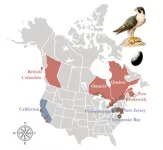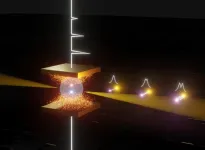(Press-News.org) Images // Video
New chemistries for batteries, semiconductors and more could be easier to manufacture, thanks to a new approach to making chemically complex materials that researchers at the University of Michigan and Samsung's Advanced Materials Lab have demonstrated.
Their new recipes use unconventional ingredients to make battery materials with fewer impurities, requiring fewer costly refinement steps and increasing their economic viability.
"Over the past two decades, many battery materials with enhanced capacity, charging speed and stability have been designed computationally, but have not made it to market," said Wenhao Sun, the Dow Early Career Professor of Materials Science and Engineering at U-M and the corresponding author of the study published in Nature Synthesis.
"A lot of times, a simple material is a good starting point, but when you add a little bit of compound A and a little bit of compound B, magic happens and you get big improvements in capacity or charging rate. However, these chemically complex materials are often difficult to manufacture at scale with high purity."
Battery materials are typically made by mixing several different oxide powders and firing them in an oven. However, these powders react in a sequence rather than all at the same time. The first two ingredients to react are usually those that release the most energy upon reacting. The first reaction results in an intermediate compound that then reacts with the remaining powder, and so on, until no more reactions are possible.
If the chemical bonds in the intermediate compounds are difficult to break, they might not fully react with the other ingredients. When they don't fully react, the intermediates hang around as undesired impurities in the final material.
"We designed a strategy to make impurity-free materials more reliably," said Jiadong Chen, the first author of the study and a U-M doctoral student in materials science and engineering and scientific computing. "The trick is to only work with two ingredients at a time, and deliberately make unstable intermediates that will react completely with the remaining ingredients."
To test this strategy, Sun's team designed 224 different recipes to create 35 different known materials containing elements used in today's batteries and next-generation 'beyond-lithium' batteries.
The researchers then partnered with Samsung Semiconductor's Advanced Materials Lab in Cambridge, Massachusetts, to test if their recipes produced these 35 materials with fewer impurities than conventional recipes. Samsung's automated robotic lab can synthesize up to 24 different battery materials every 72 hours.
Robotic arms handle the ingredients and operate the lab equipment that assesses the purity of the resulting materials. Meanwhile, computers automatically record the results of each experiment, creating a database that researchers can use to determine which recipes worked best.
"With the automatic lab, we could broadly test our hypothesis on diverse battery chemistries," Chen said.
The experiments confirmed that the new recipes with ingredients designed to be unstable tended to produce cleaner products. The new recipes improved the materials' purity by up to 80%, and six of the target materials could only be made with new recipes.
Blueprints for the robotic lab were detailed in the team's report, which Sun hopes will enable more chemistry labs to adopt robotic labs for both science and materials manufacturing.
"We need more data—not just from successful recipes but also the unsuccessful ones—to improve materials manufacturing strategies. More robotic labs will help generate the needed data," Sun said.
These labs are within reach for most research institutions and could significantly speed up materials development, the researchers say.
"The startup cost for the robotic equipment is about $120,000—not as high as you might think. But the payoffs in throughput, reliability and data-management are invaluable," said study co-author Yan Eric Wang, principal engineer and project manager of Samsung's Advanced Materials Lab.
The research was funded by the U.S. Department of Energy's Basic Energy
Sciences program.
Study: Navigating phase diagram complexity to guide robotic inorganic materials synthesis (DOI: 10.1038/s44160-024-00502-y)
END
Better battery manufacturing: Robotic lab vets new reaction design strategy
Mixing unconventional ingredients in just the right order can make complex materials with fewer impurities. The robotic lab that tested the idea could be widely adopted.
2024-04-09
ELSE PRESS RELEASES FROM THIS DATE:
Electroconvulsive therapy (ECT) shown to reduce severity of certain mental illnesses
2024-04-09
Researchers have found that Electroconvulsive Therapy (ECT), where an electric current is passed through the brain, can reduce the severity of mental illnesses.
ECT is a safe and effective treatment for some mental illnesses including severe/psychotic depression, postnatal psychosis and mania.[1],[2] Patients are placed under general anaesthetic and the brain is stimulated with short electric pulses.[3] This causes a brief seizure which lasts for less than two minutes.[3]
The use of ECT across Scotland was assessed over an 11-year period from 2009 to 2019 using data from the Scottish Electroconvulsive Therapy (ECT) Audit Network (SEAN). The Scotland-wide ...
Lonely children more likely to experience psychosis, new study finds
2024-04-09
A new study suggests that children who felt lonely for more than 6 months before the age of 12 are more likely to experience an episode of psychosis than children who did not, with women more affected than men.
Psychosis refers to a collection of symptoms that affect a person’s mind, where there has been some loss of contact with reality.[1] During an episode of psychosis, a person may have difficulty recognising what is real and what is not.[1] Symptoms of psychosis include hallucinations, delusions and confused thoughts.[2] In some instances, psychosis may be a symptom of other mental health conditions, such as schizophrenia, ...
HKUST and Tsinghua researchers develop mechanism of electrical 180° switching of Néel vector
2024-04-09
A collaborated research team led by The Hong Kong University of Science and Technology (HKUST) and Tsinghua University has theoretically proposed a new mechanism of electrical 180° switching of Néel vector and experimentally realized it in antiferromagnetic materials with spin-splitting band structure featuring the C-paired spin-valley locking, also named as altermagnet. The team also demonstrated the material's capability to manipulate Néel vector, paving the way for the manufacturing ...
Military veterans say extremism was preceded by negative service experiences
2024-04-09
Interviews with military veterans who expressed support for extremist groups or related beliefs on a prior survey show that many experienced a significant negative event during their military service, according to a new RAND report.
Researchers found that these veterans also often faced difficulties transitioning to civilian life and sometimes shared their beliefs with a wider social network.
RAND researchers conducted 21 interviews with veterans who had indicated support for one or more extremist groups or related beliefs to understand possible drivers and patterns of extremism among veterans. That support ...
Peregrine falcons expose lasting harms of flame retardant use
2024-04-09
Peregrine falcon populations across North America are heavily contaminated with harmful flame retardants–including those that have been phased out for years–according to a new study published in Environmental Science & Technology. Flame retardants are chemicals added to furniture, electronics, and other everyday products to meet flammability standards, though they often do not work as intended. They also migrate out of products they are added to and end up in wildlife and people and many are linked to serious health and environmental harms.
“Our ...
RVAM16: A low-cost multiple-ISA processor based on RISC-V and ARM thumb
2024-04-09
The increasing demand in the embedded field has led to the emergence of several impressive Instruction Set Architectures (ISAs). However, when processors migrate from one ISA to another, software compatibility issues are unavoidable. Despite the availability of software binary translation systems for ensuring software compatibility, these systems have limitations (e.g. performance and power) in low-cost embedded systems. To solve the problems, a research team led by Professor Libo HUANG published their new research on 18 Mar 2024 in ...
Will the convergence of light and matter in Janus particles transcend performance limitations in the optical display industry?
2024-04-09
A research team consisting of Professor Kyoung-Duck Park and Hyeongwoo Lee, an integrated PhD student, from the Department of Physics at Pohang University of Science and Technology (POSTECH) has pioneered an innovative technique in ultra-high-resolution spectroscopy. Their breakthrough marks the world's first instance of electrically controlling polaritons—hybridized light-matter particles—at room temperature.
Polaritons are "half-light half-matter" hybrid particles, having both the characteristics of photons—particles of light—and those of solid matter. Their unique characteristics exhibit properties distinct from both traditional ...
A gene mutation associated with a rare neurological disorder and increased susceptibility to viral infections may be treatable with oleic acid
2024-04-09
A mutation in a protein regulating natural killer (NK) cells’ function is at the root of immune deficiency in some people with a rare genetic condition characterized by cognitive and developmental delay, seizures, and other manifestations, new UCLA-led research suggests.
The researchers found that loss or mutations in a gene called MEF2C disrupted the ability of NK cells to take up chemical compounds called lipids that are used to fuel crucial functions such as tumor cell killing and creating inflammatory molecules. They found that people with the rare neurological syndrome called (MCHS) who have the mutation in this gene are particularly ...
Accurate cell type annotation for single-cell chromatin accessibility data via contrastive learning and reference guidance
2024-04-09
Chromatin accessibility, a fundamental property of DNA that plays a critical role in gene regulation and cell identity, refers to the degree that nuclear macromolecules can access and interact with DNA. With the rapid advances in single-cell chromatin accessibility sequencing (scCAS) technologies, the importance of cell type annotation in scCAS data is on the rise due to its potential to capture the chromatin regulatory landscape that controls gene transcription in each cell type. However, there are still significant limitations of existing automatic annotation methods, including low annotation accuracy, failure ...
Are lab-grown brain tissues ethical? There is no no-brainer answer
2024-04-09
Brain organoids, though often referred to as “mini brains,” are not truly human brains. But the concerns over these lab-grown brain tissues, especially when they are developed from human fetal tissues, can be very human indeed.
Researchers from the Graduate School of Humanities and Social Sciences at Hiroshima University offer valuable insights into the complexities inherent in brain organoid research, making significant contributions to the ongoing discourse surrounding this innovative biotechnology and paving the way for informed decision-making and legal and ethical stewardship in the pursuit of scientific advancement.
Their paper was published on March ...
LAST 30 PRESS RELEASES:
Interaction of climate change and human activity and its impact on plant diversity in Qinghai-Tibet plateau
From addressing uncertainty to national strategy: an interpretation of Professor Lim Siong Guan’s views
Clinical trials on AI language model use in digestive healthcare
Scientists improve robotic visual–inertial trajectory localization accuracy using cross-modal interaction and selection techniques
Correlation between cancer cachexia and immune-related adverse events in HCC
Human adipose tissue: a new source for functional organoids
Metro lines double as freight highways during off-peak hours, Beijing study shows
Biomedical functions and applications of nanomaterials in tumor diagnosis and treatment: perspectives from ophthalmic oncology
3D imaging unveils how passivation improves perovskite solar cell performance
Enriching framework Al sites in 8-membered rings of Cu-SSZ-39 zeolite to enhance low-temperature ammonia selective catalytic reduction performance
AI-powered RNA drug development: a new frontier in therapeutics
Decoupling the HOR enhancement on PtRu: Dynamically matching interfacial water to reaction coordinates
Sulfur isn’t poisonous when it synergistically acts with phosphine in olefins hydroformylation
URI researchers uncover molecular mechanisms behind speciation in corals
Chitin based carbon aerogel offers a cleaner way to store thermal energy
Tracing hidden sources of nitrate pollution in rapidly changing rural urban landscapes
Viruses on plastic pollution may quietly accelerate the spread of antibiotic resistance
Three UH Rainbow Babies & Children’s faculty elected to prestigious American Pediatric Society
Tunnel resilience models unveiled to aid post-earthquake recovery
Satellite communication systems: the future of 5G/6G connectivity
Space computing power networks: a new frontier for satellite technologies
Experiments advance potential of protein that makes hydrogen sulfide as a therapeutic target for Alzheimer’s disease
Examining private equity’s role in fertility care
Current Molecular Pharmacology achieves a landmark: real-time CiteScore advances to 7.2
Skeletal muscle epigenetic clocks developed using postmortem tissue from an Asian population
Estimating unemployment rates with social media data
Climate policies can backfire by eroding “green” values, study finds
Too much screen time too soon? A*STAR study links infant screen exposure to brain changes and teen anxiety
Global psychiatry mourns Professor Dan Stein, visionary who transformed mental health science across Africa and beyond
KIST develops eco-friendly palladium recovery technology to safeguard resource security
[Press-News.org] Better battery manufacturing: Robotic lab vets new reaction design strategyMixing unconventional ingredients in just the right order can make complex materials with fewer impurities. The robotic lab that tested the idea could be widely adopted.




